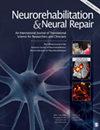Impairments in Cognitive Control Using a Reverse Visually Guided Reaching Task Following Stroke
IF 3.7
2区 医学
Q1 CLINICAL NEUROLOGY
引用次数: 2
Abstract
Background Cognitive and motor function must work together quickly and seamlessly to allow us to interact with a complex world, but their integration is difficult to assess directly. Interactive technology provides opportunities to assess motor actions requiring cognitive control. Objective To adapt a reverse reaching task to an interactive robotic platform to quantify impairments in cognitive-motor integration following stroke. Methods Participants with subacute stroke (N=59) performed two tasks using the Kinarm: Reverse Visually Guided Reaching (RVGR) and Visually Guided Reaching (VGR). Tasks required subjects move a cursor “quickly and accurately” to virtual targets. In RVGR, cursor motion was reversed compared to finger motion (i.e., hand moves left, cursor moves right). Task parameters and Task Scores were calculated based on models developed from healthy controls, and accounted for the influence of age, sex, and handedness. Results Many stroke participants (86%) were impaired in RVGR with their affected arm (Task Score > 95% of controls). The most common impairment was increased movement time. Seventy-three percent were also impaired with their less affected arm. The most common impairment was larger initial direction angles of reach. Impairments in RVGR improved over time, but 71% of participants tested longitudinally were still impaired with the affected arm ∼6 months post-stroke. Importantly, although 57% were impaired with the less affected arm at 6 months, these individuals were not impaired in VGR. Conclusions Individuals with stroke were impaired in a reverse reaching task but many did not show similar impairments in a standard reaching task, highlighting selective impairment in cognitive-motor integration.中风后使用反向视觉引导到达任务的认知控制障碍
背景认知和运动功能必须快速无缝地协同工作,才能让我们与复杂的世界互动,但它们的整合很难直接评估。互动技术提供了评估需要认知控制的运动动作的机会。目的将反向到达任务应用于交互式机器人平台,以量化中风后认知运动整合的损伤。方法亚急性脑卒中患者(N=59)使用Kinarm进行两项任务:反向视觉引导达及视觉引导达。任务要求受试者将光标“快速准确”地移动到虚拟目标。在RVGR中,光标运动与手指运动相反(即,手向左移动,光标向右移动)。任务参数和任务得分是根据健康对照组开发的模型计算的,并考虑了年龄、性别和惯用手的影响。结果许多中风参与者(86%)的RVGR受损,其受影响的手臂(任务得分>95%的对照组)。最常见的损伤是运动时间增加。73%的人的手臂受影响较小,也有损伤。最常见的损伤是接触的初始方向角较大。RVGR的损伤随着时间的推移而改善,但71%的纵向测试参与者在中风后6个月仍然受到影响。重要的是,尽管57%的患者在6个月时受影响较小,但这些患者的VGR没有受损。结论中风患者在反向达到任务中受损,但许多人在标准达到任务中没有表现出类似的损伤,这突出了认知-运动整合的选择性损伤。
本文章由计算机程序翻译,如有差异,请以英文原文为准。
求助全文
约1分钟内获得全文
求助全文
来源期刊
CiteScore
8.30
自引率
4.80%
发文量
52
审稿时长
6-12 weeks
期刊介绍:
Neurorehabilitation & Neural Repair (NNR) offers innovative and reliable reports relevant to functional recovery from neural injury and long term neurologic care. The journal''s unique focus is evidence-based basic and clinical practice and research. NNR deals with the management and fundamental mechanisms of functional recovery from conditions such as stroke, multiple sclerosis, Alzheimer''s disease, brain and spinal cord injuries, and peripheral nerve injuries.

 求助内容:
求助内容: 应助结果提醒方式:
应助结果提醒方式:


